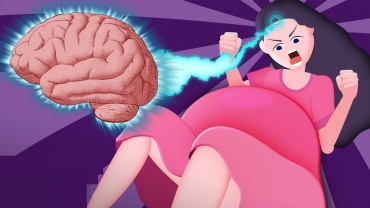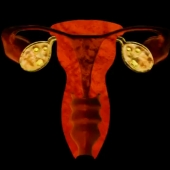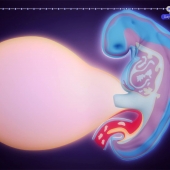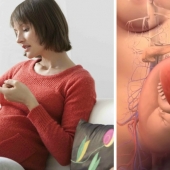Atresia of the duodenum is a birth defect in which the first part of a baby's small intestine, called the duodenum, is blocked. Located between the stomach and large intestine, the small intestine absorbs nutrients from food.
The small intestine has three parts, the duodenum, the jejunum, and the ileum. The duodenum forms during the sixth week of pregnancy. Here you can see the tube that will become the digestive system.
The duodenum grows just below the developing stomach. The cells inside the duodenum grow so fast that the tube becomes blocked for a while. Later, as part of normal development, the cells blocking the inside of the duodenum die off until the developing intestine is open again.
By about the 10th week of pregnancy, for unknown reasons, the outside wall of the duodenum may not have grown properly. In addition, the cells blocking the inside of the duodenum may not have died off.
As a result, a defect called duodenal atresia in which a part of the duodenum is blocked in one or more ways. It may be blocked by a web of tissue lining the inside or a section of the duodenum may be completely missing.
Finally, the duodenum may be narrowed. Any of these types of atresia prevent the baby from absorbing nutrients from milk because the fluid can't pass through the duodenum. Duodenal atresia is not immediately life-threatening.
But it will require in operation within a few days after birth to repair the blocked duodenum. Before the operation, a suction tube, or NG, inserted soon after birth through the nose or mouth, will remove excess fluid and air from the stomach.
The baby will be given general anesthesia to put him or her to sleep for the entire operation. A breathing tube will be inserted through the nose or mouth and into the windpipe to help the baby breathe during the operation.
Commonly, the surgeon will make an incision under the ribs on the right side. Next, the surgeon will carefully find the atresia, or narrow and blocked part of the baby's duodenum. Two incisions will be made in the duodenum above and below the atresia. The surgeon will use sutures to connect the two openings, thus, bypassing the atresia.
Finally, the surgeon will close the skin incision with dissolvable sutures or skin closure strips. After the operation, the baby will be taken to the Neonatal Intensive Care Unit for monitoring. Pain medication will be given. The baby may continue to receive antibiotics through the IV. The baby will be released from the hospital within two to four weeks when the digestive system is working normally.
- 241 views













